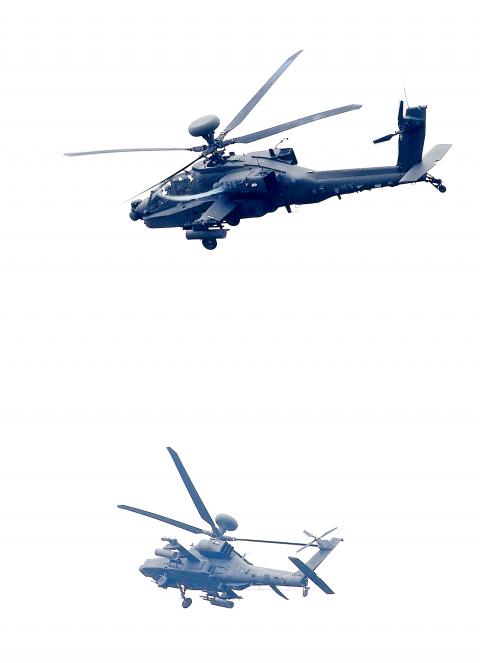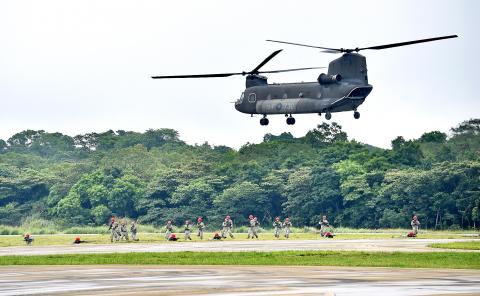The military is to conduct war games simulating an attack involving the Chinese People’s Liberation Army Navy’s sole aircraft carrier, the Liaoning, against bases on the nation’s eastern seaboard, sources said.
Maritime Port Bureau flight safety information showed that the military is to conduct what it calls the Joint-Electronic 107-2 exercises on Tuesday and Wednesday after a final rehearsal tomorrow.
The military had already conducted two rehearsals on Thursday and Friday.

Photo: Peter Lo, Taipei Times
Republic of China (ROC) Navy fast combat support ship the Panshi, which has the greatest displacement of ships in service, is to play the role of the Liaoning, launching simulated air raids on the Chiashan (佳山) Air Base in Hualien and other military installations, sources said.
ROC Army Aviation and Special Forces Command are to deploy rotary-wing aircraft in the role of the aggressor, while the air force and navy are to furnish additional fixed-wing aircraft and warships for the exercise, they said.
Military bases on the east coast would also be subjected to electronic interference, they said.

Photo: Peter Lo, Taipei Times
The drill is to test the military’s resilience against a coordinated air and electronic attack, while increasing the joint warfare capability of the armed forces, the sources said.
As a rule, past military exercises in the Joint-Electronic rubric rarely involved units not tasked with electronic warfare, they added.

LIMITS: While China increases military pressure on Taiwan and expands its use of cognitive warfare, it is unwilling to target tech supply chains, the report said US and Taiwan military officials have warned that the Chinese People’s Liberation Army (PLA) could implement a blockade within “a matter of hours” and need only “minimal conversion time” prior to an attack on Taiwan, a report released on Tuesday by the US Senate’s China Economic and Security Review Commission said. “While there is no indication that China is planning an imminent attack, the United States and its allies and partners can no longer assume that a Taiwan contingency is a distant possibility for which they would have ample time to prepare,” it said. The commission made the comments in its annual

DETERMINATION: Beijing’s actions toward Tokyo have drawn international attention, but would likely bolster regional coordination and defense networks, the report said Japanese Prime Minister Sanae Takaichi’s administration is likely to prioritize security reforms and deterrence in the face of recent “hybrid” threats from China, the National Security Bureau (NSB) said. The bureau made the assessment in a written report to the Legislative Yuan ahead of an oral report and questions-and-answers session at the legislature’s Foreign Affairs and National Defense Committee tomorrow. The key points of Japan’s security reforms would be to reinforce security cooperation with the US, including enhancing defense deployment in the first island chain, pushing forward the integrated command and operations of the Japan Self-Defense Forces and US Forces Japan, as

‘TROUBLEMAKER’: Most countries believe that it is China — rather than Taiwan — that is undermining regional peace and stability with its coercive tactics, the president said China should restrain itself and refrain from being a troublemaker that sabotages peace and stability in the Indo-Pacific region, President William Lai (賴清德) said yesterday. Lai made the remarks after China Coast Guard vessels sailed into disputed waters off the Senkaku Islands — known as the Diaoyutai Islands (釣魚台) in Taiwan — following a remark Japanese Prime Minister Sanae Takaichi made regarding Taiwan. Takaichi during a parliamentary session on Nov. 7 said that a “Taiwan contingency” involving a Chinese naval blockade could qualify as a “survival-threatening situation” for Japan, and trigger Tokyo’s deployment of its military for defense. Asked about the escalating tensions

The Ministry of Economic Affairs said it plans to revise the export control list for strategic high-tech products by adding 18 items under three categories — advanced 3D printing equipment, advanced semiconductor equipment and quantum computers — which would require local manufacturers to obtain licenses for their export. The ministry’s announcement yesterday came as the International Trade Administration issued a 60-day preview period for planned revisions to the Export Control List for Dual Use Items and Technology (軍商兩用貨品及技術出口管制清單) and the Common Military List (一般軍用貨品清單), which fall under regulations governing export destinations for strategic high-tech commodities and specific strategic high-tech commodities. The